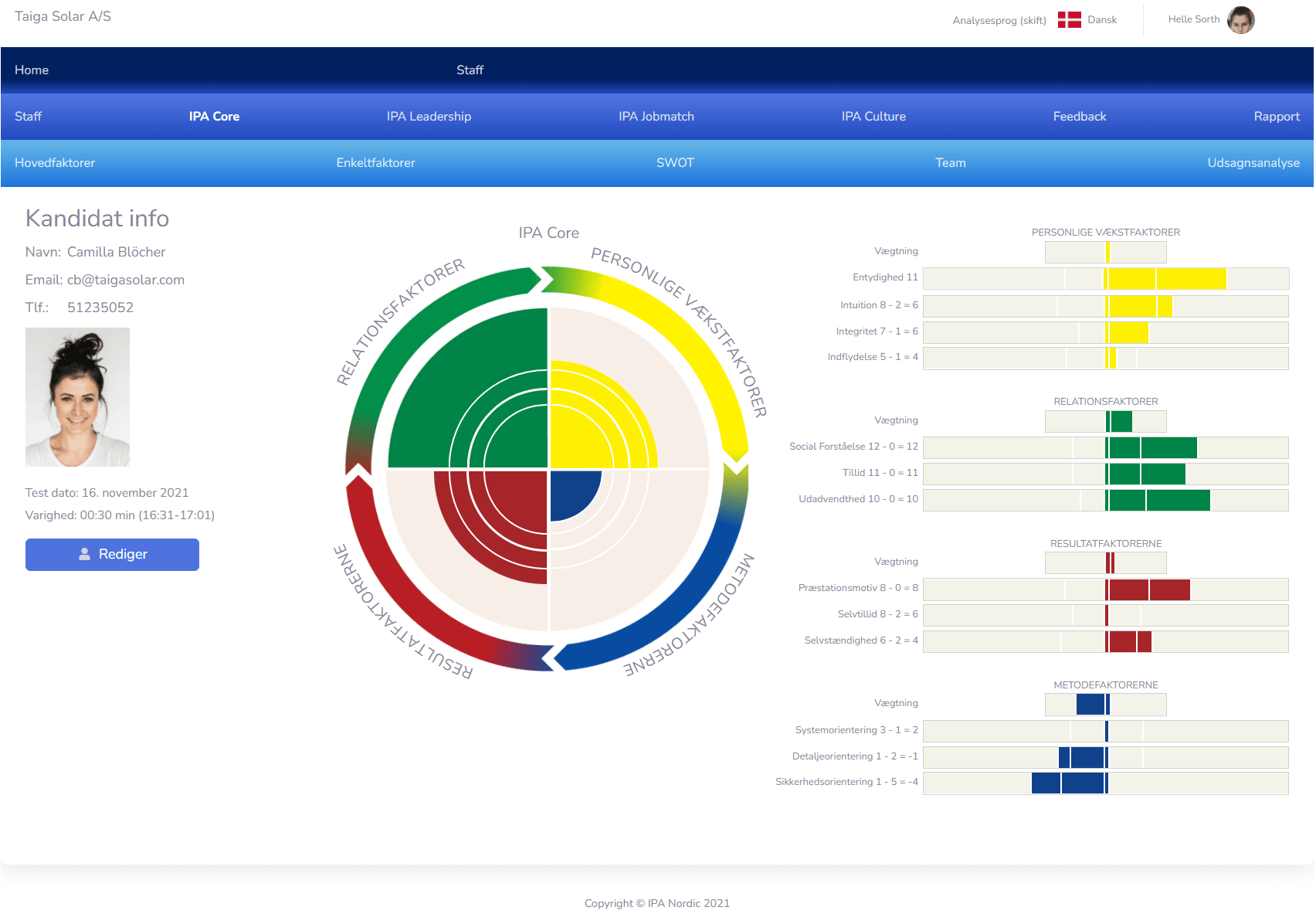Highest rated research in the Nordics
Available to 82% of the world’s
population in their native language
Introduction til IPA Core Personality
IPA Core is a personality analysis and is a conversation starter where the outcome and quality is created in the dialog between two people.
The 12 personality traits of the IPA Core Analysis are divided into four main factors, each illustrated in a different color. Each core factor should be seen as a mental platform on which we build a range of personal experiences and skills throughout our lives, which we apply in the workplace. The four main factors are connected and integrated in such a way that the quality and content of what we learn and develop on one platform is dependent on what we have learned and developed on the other platforms.
Thus, we fundamentally perceive the personality as a whole, where everything is interconnected. We always interpret the individual factors based on this personality whole.
Researcher Flemming Olsen talks about IPA Core Personality
Researcher Flemming Olsen talks about the highest rated research
Researcher Flemming Olsen talks about the integral idea
Researcher Flemming Olsen talks about the colours in the IPA analysis
Why choose IPA Core Personality?
Highest rated personality analysis
The founder of IPA Nordic, Flemming Olsen, has been given the highest rating among Nordic personality assessment providers by the Swedish Psychological Association.
Multi language
The IPA Core Personality covers more than 80% of the world’s population.
State of the art technology
Along with IPA Core comes IPA 360° Cockpit, where analytics can be processed and analyzed.
See IPA 360° Cockpit
IPA Core – Main Factor # 1
Method Factors
The ability to operate in an unpredictable and chaotic world without knowing the outcome of certain actions and decisions.
Core motive: Need for security
Forms: Safety
Color: Blue

Personality Trait # 1
System oriented
The need to be in a world characterized by order, regularity and stability. Finding safety and security in the orderly and planned. Getting an overview by systematizing and structuring your efforts

FLEXIBILITY
This is the person who is comfortable with tasks that are solved in a changing and shifting universe. They want to find their own way and have the freedom to improvise in response to whatever comes up.
SYSTEM ORIENTED
This is someone who is comfortable in a setting that is characterized by order, regularity, and stability. She seeks to obtain a clear overview through clear conditions, clear rules, and firm structures.
Personality Trait # 2
Detail orientation
This factor concerns the need to solve tasks in a setting where it is clear what the result is supposed to be. The need to avoid mistakes through a meticulous and careful approach to the tasks. The need to ensure that the result is completely flawless. The need to have routines, professional immersion, and the possibility of working with all aspects of the given tasks.

HOLISTIC
This is the person who is most comfortable with tasks where the path must often be found in the big picture. These are tasks that are characterized by not knowing the outcome in advance, but also by the fact that the very basis for performing the task may be undefined.
DETAIL ORIENTED
This is the person who has the patience and interest to get deeply involved in each task. They need to be able to ensure that the task is 100% correct and therefore free of errors and omissions. Persistent.
Personality Trait # 3
Security orientation
The need to work in a predictable world where you know the consequences of your choices and actions. The desire to be in familiar surroundings where you can feel confident in making the right decisions. The urge to avoid the unknown and the surprising.

RISK ORIENTED
This is the person who is a spontaneous and quick decision-maker in many situations and would rather take a risk than wait too long. You’re comfortable with tasks where you don’t know the full consequences of your decisions in advance, and they’re happy to push the button and set things in motion without being sure where they’ll end up.
SAFETY ORIENTED
This factor concerns the need to work in a predictable setting where the consequences of one’s choices and actions are known in advance. The need to be in well-known surroundings in which one can feel safe that the correct decisions are made. The need to avoid unknown and surprising situations.
IPA Core – Main Factor # 2
RESULT FACTORS
The ability to manage difficult, critical, and challenging situations, set up goals and overcome the obstacles that may arise on the way.
Core motive: The need is self-assertion
Form: Achievement
Colour: Red

Personality Trait # 4
Presentation motif
Building your self-esteem on what you can achieve in comparison to others. Accomplishing what you set out to do. To challenge yourself and change your abilities and skills. Pursuing your own goals and being oriented towards expansion and victory.

LOW PERFORMANCE MOTIVE
This is the person who is more oriented towards the community and the group’s results than their own performance and results. They don’t want to be highlighted at the expense of others and are generally a person who cares more about the community and what they do together than about individual performance.
HIGH PERFORMANCE MOTIVE
This is the person who is driven by an inner urge to always perform at their best, constantly seeking to improve in order to become better, faster and more efficient in the execution of their tasks. They have the will and energy to achieve the goals that have been set and the results that have been achieved.
Personality Trait # 5
Self-confidence
The conviction that you can, the strength with which you believe in yourself. The inner reservoir of personal success experiences that you can draw on in critical and difficult situations. The way we draw energy to overcome adversity and persevere when faced with new challenges.

UNSURE OF ONESELF
This is the person who struggles to maintain self-confidence in critical situations. They often doubt their abilities, especially in new and unfamiliar situations. This is the person who prefers to stay on familiar ground and worries when faced with the unknown and the untried.
TRUSTS THEMSELVES
This is the person who trusts themselves and their abilities in critical and difficult situations. Possesses an inner belief that things can be done despite obstacles and resistance. This is the person who has a fundamentally positive view of themselves, their abilities and opportunities, and therefore rarely has doubts.
Personality Trait # 6
Independence
Having personal responsibility for your own tasks. The desire to do things yourself without interference from others. The need for freedom from restrictions, limitations and external control. Wanting to do things yourself and being free to do them your own way. Being critical of authority.

TEAM ORIENTED
Det er personen, der har det bedst i et arbejdsmiljø, hvor man bruger hinanden, spørger hinanden til råds og blander sig i hinandens måde at løse opgaverne på. Det er den teamorienterede, der mener, at den enkelte må indordne sig de gældende spilleregler og de fælles vilkår, der nu engang gælder og personen, der accepterer sin plads i teamet.
FREEDOM ORIENTED
Det er personen, der motiveres af frihed og mulighed for selv at sætte dagsordenen, for selv at bestemme, hvordan opgaverne skal løses og for selv at sidde med ansvaret for at tingene lykkes. Det er trangen til at være fri og uafhængig af andre og være fyldt af den berusende lykke, det er at kunne klare tingene uden andres hjælp.
IPA Core – MAIN FACTOR # 3
RELATIONSFACTORS
The ability to manage social situations using insight in both oneself and others, to be able to get involved in and connect with others in order to get the needed results
Core motive: To be something with others
Form: Social Understanding (competence)
Colour: Green

Personality Trait # 7
Social Understanding
The basic need and interest in creating positive feelings and experiences with other people. The insight and understanding of other people’s feelings, attitudes and judgments. Sensitivity to the social and emotional space that surrounds you.

CASE ORIENTED
This is the person who often struggles to understand why other people act the way they do. Their motives, their thoughts and their feelings. They wonder and in many situations use their principles and firm belief in discipline to guide their actions towards others. This is the person who believes that a deal is a deal.
PEOPLE ORIENTED
This is the person who sees a personal quality of life in creating deep and trusting relationships with other people. Who values deep conversations about often difficult questions, feelings, relationships, actions and consequences. This is the person who is simply interested in what is going on in others and what is going on in themselves.
Personality Trait # 8
TRUST
The basic need and interest in creating positive feelings and experiences with other people. The insight and understanding of other people’s feelings, attitudes and judgments. Sensitivity to the social and emotional space that surrounds you.

SCEPTIC
This is the person who in many situations has a skeptical and wait-and-see attitude towards other people. Who keeps most people at a distance and prefers to look at other people before opening up.
TRUSTFUL
This is the person who has a fundamentally positive view of other people, who trusts others and believes the best about their fellow human beings. On this basis, you are an open person who talks about yourself, your experiences, feelings and opinions almost spontaneously.
Personality Trait # 9
Extroversion
Our urge to share, test and pay attention to the world and people around us. Wanting to be with others, to actively seek out others. The need for attention and this throwing questions out into the environment to get an answer back.

INTROVERT
This is the person who often keeps their thoughts and opinions to themselves until they have been processed in their own inner universe. They can be perceived as a reserved and cautious person who spends a lot of time thinking things through before speaking up.
EXTROVERT
This is someone who will readily share her opinions and experiences, and she is always visible and talkative in social contexts. This is someone who is extrovert and social, and she will readily speak to anyone. This is also someone who feels that sharing thoughts and feelings in social interactions is beneficial.
IPA Core – MAIN FACTOR # 4
PERSONAL GROWTH FACTORS
The ability to focus on oneself and view the world from one’s own ideas and conceptions, to be able to actualize one’s full potential.
Core motif
Need: Need for freedom
Colour: Yellow

Personality Trait # 10
Intuition
Having a positive expectation and belief that it is possible to shape and influence the world around you. To manage your inner imagination with excitement, enthusiasm and an optimistic belief that anything is possible. Handling the art of possibilities and finding solutions in a blocked situation.

FACT DRIVEN
It is the person who has a sober, realistic and often rational approach to reality, its possibilities and perhaps most importantly its limits. It is the practitioner who relies most on the tangible and the provable, and who assesses things based on what they believe is actually possible. Often bases their problem solving on what has been tried before.
IDEA DRIVEN
This is someone who has a fundamentally positive belief in the future and is convinced that almost anything is possible. She has a basic inner belief that there is always a way of untangling a difficult situation. To this person, the road to success is paved with great ideas that might begin as small notions, only to grow into more concrete solutions.
Personality Trait # 11
Integrity
Understanding and recognizing conflict as a necessary prerequisite for personal growth and development. Dealing with crises, both in oneself and others. The inner strength to set boundaries, take a stand and stand firm in the face of adversity and resistance.

VULNERABLE
Det er personen, der helst går i en stor bue udenom alt det, der kan skabe konflikter, uro og ubalance i vedkommendes liv. Det er personen, der har svært ved at sige fra, sætte grænser og tackle direkte personlige angreb. Den grundlæggende holdning er, at der sjældent kommer noget godt ud af konflikter og, at der skal betales en alt for høj pris i forhold til hvad, der kan opnås.
ROBUST
Det er personen, der bliver stående på sine synspunkter når vinden blæser imod, som forsvarer sig selv og sin integritet, når han eller hun kommer under angreb. Vedkommende giver klart udtryk for, hvor grænsen går og reagerer i situationer, hvor han eller hun føler, at den bliver overskredet.
Personality Trait # 12
Influence
The degree of influence an individual wants to exert over another. The ability to embrace authority and make decisions for oneself rather than leaving it to others. To manage and direct people towards certain goals. To master and control others.

INFLUENCE GIVING
This is the person who prefers to steer clear of anything that can create conflict, turmoil and imbalance in their life. This is the person who struggles with speaking up, setting boundaries and dealing with direct personal attacks. The basic attitude is that good things rarely come out of conflict, and the price to be paid is far too high compared to what can be achieved.
INFLUENCE SEEKER
This is someone who fundamentally desires to take on responsibility and make decisions, and this person will naturally take on any influence she can. The reason for this is a desire to lead, but also to receive the recognition that accompanies this position.
Personality Trait # 13
Unambiguity
This factor is calculated from the sum of the number of contradictions on each personality trait.
Unambiguity is defined as… The degree to which a person knows himself and sees himself clearly on the personality traits measured in the IPA Analysis.

LOW UNAMBIGUITY
This is the person who prefers to steer clear of anything that can create conflict, turmoil and imbalance in their life. This is the person who struggles with speaking up, setting boundaries and dealing with direct personal attacks. The basic attitude is that good things rarely come out of conflict, and the price to be paid is far too high compared to what can be achieved.
HIGH UNAMBIGUITY
A person with HIGH unambiguity sees themselves and knows themselves clearly on the factors we measure with the IPA Analysis. It is also a person who remains the same despite the vicissitudes of the environment. We will often find a person with High Unambiguity to be very clear, stable and legible in their behaviour.
This is how the flow works:
– From the IPA 360° Cockpit, a unique link is sent to the candidate/employee
– The candidate chooses their own language
– It takes approx. 25 minutes to complete
– Information about the completed answer is sent automatically
– In the IPA 360 Cockpit, the answer can be analyzed, and the built-in feedback questions and logical manual ensure optimal feedback.
– There is a dynamic report generator where the report can be freely compiled
– There is a best practice 24-page report for the client and a 12-page candidate/employee handout.




